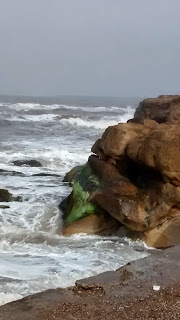 |
| Waves crashing around the rocks at Amble. Coquet Island is behind the rock |
A highlight of the trip was a visit to the Franciscan friary at Alnmouth (which I had heard much about from friends who are members of the Third Order of Franciscans, following the way of St Francis in everyday life under vows but not in a residential community). We had tea and conversation with a range of people staying with the friars as a retreat house, before evening prayer filled us with a sense of peace and the presence of God. St Cuthbert in particular resonates with me, and I read much about him before my birthday trip to Durham a few years ago to see the Lindisfarne gospels.
One place remains to be visited on another occasion: the holy island itself, perhaps next Easter with thousands of other pilgrims.
This week, I have been reading a beautifully illustrated book "How Christianity Came to Britain and Ireland", setting Cuthbert in his context. The first thousand years after Jesus' birth in Britain was shaped by waves of invaders, each of whom encountered the faith at different times. In York, Constantine was declared emperor and soon afterwards became a Christian, ending the state-sponsored persecution of Christians (at least for a while). The first record of Christians in York is Bishop Eboricus in 314, but after this, the Roman state collapsed and waves of invasions by Angles, Saxons and Jutes pushed the Romano-British faith to the edges - Wales, Cornwall, Scotland and Ireland. This is where it flourished in places like Iona, who eventually sent missionaries like Aidan and Cuthbert to reach the Anglo-Saxon kingdoms.
Mission also came from Rome, via St Augustine of Canterbury and Paulinus who baptised Edwin king of Northumberland in York on Easter Day 627 along with St Hilda of Whitby. The place just outside the Minster (which was in their day a small wooden church) where they were baptised is still used today, in the great outdoor Easter baptisms where people from across the city come to tell their testimonies and be baptised by their own minister and Archbishop John Sentamu.
 |
| Try Praying banners appearing across York |
Tomorrow evening we will celebrate Pentecost with a thousand strong congregation from churches across the city filling the nave of the Minster and launching the TryPraying initiative which challenges anyone and everyone to try praying for 7 days and see what happens. The service ends as it does each year, with flaming torches representing the flames that people saw when the Holy Spirit came at Pentecost, held aloft by the newly appointed Mayor and Sheriff leading us in procession out through the great West doors into the street. It's a great way to make someone nervous - on one of your first civic occasions, do take care not to burn down the Minster...
There is in York an ongoing sense of history. Our heritage breathes through us, we are surrounded by it, and if we will listen and learn to see, it speaks afresh to us today. May that be our experience this Pentecost.
See also:
No comments:
Post a Comment